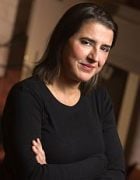
The NCCO is a string orchestra composed of 19 players, so they couldn’t possibly perform Ravel’s famous, full-bodied orchestration of Mussorgsky’s piano suite Pictures at an Exhibition. What they could do is commission a new orchestration of it by Clarice Assad, and play it with the addition of Roxanne Michaelian on piano and Galen Lemmon, the go-to man for all things percussion in the South Bay, behind a battery of some 25 percussion instruments.
Music Director Nadja Salerno-Sonnenberg succeeded in leading the entire thing from her concertmaster’s seat, directing the cellos when they were playing and the violins were not by bouncing up and down in her chair, rather than by conducting with her bow.
Assad had shown herself, during previous service as NCCO’s composer in residence, to be an arranger and orchestrator of great imagination, and she proved it again here. This piece was great fun, more fun than it’s probably licit to have on the anniversary of 9/11. Passages for the full ensemble — fewer of those than you might think — alternated with dips into chamber music: violin and piano, or cello (Robin Bonnell) and piano, or the slow middle section of “The Great Gate of Kiev” magically set for string quartet.
The orchestration is full of little added touches for the strings that enhance, rather than distract from, the effect of Mussorgsky’s work: ghostly harmonics for solo violin in “With the Dead in a Dead Language,” and glissandos everywhere. Assad made no better decision than to give the main theme in “The Old Castle” to a solo viola, played by Anna Kruger. In Ravel it’s an alto saxophone. The substitution seems simple, but the effect was astonishing. It sounded more like the sax than a sax does. If only the solo cello in “Bydlo” had been as effective — I wonder if Assad had considered giving that to the string bass.
Some of the percussion effects worked well. The glockenspiel is well-suited to take over the part of the whining Schmuyle (Ravel uses trumpet) in the “Samuel Goldenberg” picture. The flexatone, or so I’m guessing it was, matching the rising scale that concludes “Tulleries,” was a delight. Interesting things were done with the piano, as well. I liked the effect of hammering on the strings to make the instrument sound like a harpsichord. Yet at times the percussion did not seem well-integrated with the string orchestra. I do not mean to criticize either Lemmon’s crackerjack performance or anyone else’s. It was a matter of sonority rather than ensemble that the tubular bells clanging away at opportune moments gave an incongruously Christmassy feeling to parts of the work.
In the end, the “Kiev Gate” — perhaps the most challenging section to follow in Ravel’s footsteps — came out the best. The full orchestra cuts out suddenly at the end of “Baba Yaga’s Hut,” leaving Mussorgsky’s solo piano to begin this movement. (Take that, Ravel!) Then comes the quiet part for string quartet; by the end, the full orchestra is accompanied sequentially by bells, tam-tam, and bass drum.
Bach ... Sort Of
For the other half of the program, we had altered Bach. There is a theory that his Clavier Concerto in D Minor, BWV 1052, is actually an arrangement of a lost violin concerto, and attempts have been made to reconstruct the hypothesized original. Rosemary Delia’s program note was inclined to dismiss this notion, but that didn’t stop NCCO from performing Robert Reitz’ arrangement. Adding support for the violin theory, the result worked pretty well. Salerno-Sonnenberg’s characteristic underplaying in the solo part, swallowing her notes and hiding behind the sound of the orchestra, did not interfere with the enjoyability of the whole.The other not-quite-Bach on the program was Mark Starr’s “hypothetical orchestral model” of the Chaconne in D Minor, from the Partita No. 2 for solo violin. It was very nice — indeed, positively beautiful — though it isn’t Bach. A large part of the Chaconne’s effect comes from the strain on the violinist of playing sometimes on all four strings at once, and on maintaining a harmonic underpinning in the parts for only one string at a time. By splitting those multiple stops into chords for the four sections of the string orchestra, and adding his own harmonic supports to the melodic line, Starr washes Bach’s querulousness down into a tamed pastiche of Baroque style from the harmonic viewpoint of a later time. As a result, the Chaconne sounded like an outtake from Edvard Grieg’s Holberg Suite, a work for strings that fits that description by intent.
Still, it is a skillful arrangement, enjoyable for what it is, and the NCCO played it superbly, at a blazing speed. The orchestra’s skill and confidence throughout the entire challenging program was a delight to the ear.

